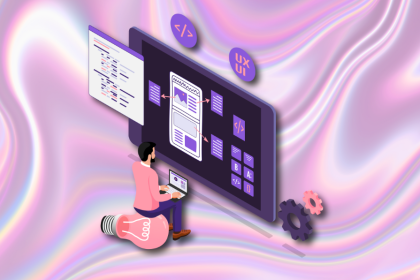As UX designers, our top priority is to advocate for our users by suggesting improvements that can have an impact on their user experience and the product’s success. Things like reducing friction, increasing engagement, and increasing delight for our users. But even when UX initiatives are backed by research and insights, they often struggle to find a place on the product roadmap.

The challenge isn’t that the initiatives lack value; it’s a matter of alignment. Product managers prioritize based on business goals, metrics, and deadlines, while designers focus on user experience and usability. Without having a clear connection between the two, UX work can often be deprioritized or overlooked entirely.
In this article, we’ll explore practical strategies for UX designers to ensure that design-led initiatives resonate with PMs. These strategies include framing design work in measurable terms, demonstrating value through prototypes and storytelling, and aligning initiatives with roadmap goals and timing. By bridging the gap between user needs and business priorities, UX designers can make sure their work drives meaningful outcomes for both users and the product.
To start off, it’s important to understand that PMs and designers are partners on the same team. We work together alongside engineers, sales, and other team members to achieve the same company goals. Each role just has a different set of priorities, metrics, and objectives to aim for. PMs have different priorities and KPIs that can sometimes conflict with those of the UX team. What feels like a top priority for a designer might rank lower on a PM’s list, but that doesn’t change the fact that we’re all driving toward the same outcome.
It can be frustrating when UX designers don’t see eye to eye with PMs on which projects get greenlit, but before we can influence those decisions, we must put ourselves in their shoes. PMs constantly balance competing goals and are accountable for business outcomes such as market growth, user acquisition, retention, and engagement. Designers, on the other hand, tend to focus on metrics relating to usability, accessibility, and UI consistency.
While these areas are connected, many designers struggle to clearly link UX work to measurable business results, which widens the gap between the two roles. And even when the connection can be communicated, UX improvements often take longer to show impact compared to a new feature launch. Much of good design is felt rather than immediately measured, unless backed by ongoing satisfaction or retention metrics.
Another reason PMs may seem misaligned with UX priorities is that there’s always more to do than there is time in a quarter. When bandwidth is limited and efficiency is critical, only initiatives that directly support the company’s strategic goals make it onto the roadmap. The rest get deferred, which keeps organizations focused and helps them avoid wasting resources on what’s not essential right now.
Most PMs actually value UX and care deeply about their users, but they’re under constant pressure to make tough prioritization decisions. Suppose a UX initiative doesn’t clearly connect to business impact or short-term goals. In that case, it risks getting delayed or deprioritized, not because they are unimportant, but because it’s not yet seen as essential to moving the business forward. UX designers need to show how improving usability or adopting design system patterns can directly support goals like increasing sign-ups, boosting retention, or driving engagement.
Working alongside senior designers and PMs, I noticed how effective teams frame UX outcomes in terms of business goals. After conducting user research and gathering data on pain points and motivations, we translated our findings into numbers that PMs could easily interpret within their prioritization models. This made it easier for everyone to see the expected results relative to the effort required.
For example, if a signup form is confusing users, leading to drop-off halfway, you could present this finding as: “40% of users abandon the sign-up form before completing it. Fixing this could increase conversions by up to 25%, based on the current drop-off rate.”
You don’t need a dedicated data science team to make this case. Small indicators like support ticket frequency or recurring customer complaints can help you anchor your argument. This is also when storytelling becomes powerful. Use user quotes, pain points, or a simple before-and-after prototype to illustrate the cost of inaction and make your solution tangible for stakeholders.
If your initiative ties back to a customer need or company goal, it immediately strengthens your case by aligning with an active strategic objective. Our UX team had long wanted to redesign the interactions of a toolbar that appeared on a canvas workspace, which was implemented during the product’s early days. However, it kept getting deprioritized for higher-impact projects.
A few quarters later, our company’s OKRs shifted to upgrading the canvas experience for enterprise customers, so I framed the toolbar redesign as part of that effort. To gain buy-in from our PM team, I communicated how it would reduce friction for power users and directly support our enterprise usability goals. That strategic alignment finally helped the initiative gain traction and secure a spot on the roadmap.
Sometimes, even if you’ve done thorough research and clearly communicated the customer value, you still won’t get buy-in for your UX initiative. Often, that’s because the conversation is happening too late. Once the roadmap is set, discussions with PMs tend to become negotiations rather than collaborations. These conversations need to happen earlier, ideally during discovery, before any proposals are even formed.
Involve your PMs early in the discovery process. Co-own user problems by collaborating on user interviews, workshops, and research synthesis. During these sessions, I often use journey maps to visualize user experiences, pain points, and goals. This helps stakeholders align on where to focus first. I also create quick, low-fidelity Figma prototypes to bring concepts to life during user sessions. Building these prototypes alongside PMs ensures that both usability and product perspectives are considered from the beginning. Their input from a product and customer use case perspective really helps create a relevant proposal that can be shared and reviewed by our users.
When PMs see user pain points firsthand and hear their feedback directly, it builds shared context and empathy. And when they collaborate on the solutions themselves, it creates a sense of ownership and urgency, which makes them far more likely to prioritize the initiative later on.
The reality of working on a high-performing product team is that you’ll inevitably face pushback on your UX pitches. There are many valid reasons why an initiative might not make it onto the roadmap that are rarely about the quality of the idea. First of all, timing plays a big role. Your proposal needs to align with current business goals, address urgent customer needs, or help unblock another team’s work to gain traction.
Opportunity cost is another factor that should be considered. Every initiative competes for limited resources, so PMs must constantly weigh potential impact against effort, dependencies, and delivery timelines. From their perspective, even strong UX improvements might take a back seat if another project promises higher ROI or more immediate business results.
Becoming more product-minded can help designers understand how PMs think when prioritizing initiatives. While designers are trained to advocate for users and champion usability, thinking like a product partner means evaluating ideas through the lens of business impact. Next time you’re getting ready to propose a UX initiative, ask yourself: “Which projects are positioned to drive growth, improve retention, or help the company reach a key objective?” Those are the ones worth pushing for.
For example, if you’re deciding between updating an old page’s visual layout to match the design system or streamlining the checkout flow that users frequently abandon, the latter has more potential to drive conversions and revenue, while the former may be a quality-of-life improvement. Both matter to user experience, but one directly supports a measurable business goal, while the other may be nice to have.
This doesn’t mean that we should compromise on user experience or give up fighting for our users. It just means being more strategic about where to invest your influence. Some UX improvements could be valuable, but may not move the needle compared to other initiatives that are competing for resources. By identifying which UX opportunities directly support business outcomes, designers can advocate more effectively, align with PM priorities, and ensure their work creates both user and organizational value.
Before proposing a UX initiative, it’s worth taking a step back to assess how well it’s positioned to resonate with your PM and broader product team. This isn’t about communicating the value of your idea. This is about making sure it fits naturally within the team’s priorities and decision-making framework.
Here are a few questions to ask yourself as a quick evaluation tool before you bring your pitch to the table:
Start by grounding your initiative in something already on the team’s radar. If your idea directly supports an active OKR, aligns with a strategic roadmap theme, or addresses a recurring customer complaint, it immediately gains interest, not to mention credibility. PMs are far more receptive to proposals that solve known problems rather than introduce entirely new ones. And ensuring customer satisfaction can be even more important than introducing a new feature. When customers are unhappy and even threatening to churn, solving their problems becomes a top priority. Designers should monitor feedback channels and regularly sync with their sales and customer success teams, to get a pulse on what’s been frustrating users and what UX improvements have the best chance of being green-lit.
Translate your UX improvement into measurable business outcomes. For example, instead of saying “this change will make navigation easier,” say “this could solve users’ frustrations with navigation, reducing drop-off of this feature by 30%.” Speaking in terms of metrics PMs care about makes your proposal more concrete and comparable against other priorities. Some relevant metrics to consider include conversion rates, retention, cost, and time.
A simple visualization can help stakeholders understand an abstract idea by having something to look at and ask questions. Whether it’s a journey map highlighting user friction or a quick prototype that shows how a flow could work better, visual artifacts make it easier for PMs to understand the impact at a glance. When you support your argument with visual evidence, you immediately seem prepared to have a serious discussion.
Before pitching, consider how your initiative fits within current resources, deadlines, and team capacity. My team follows an agile approach, focusing on small, continuous improvements to the product. I’ve learned that while my proposals can be visionary, they often need to be scaled back into a phased approach to reach the final state over time. Being transparent about what’s realistic and outlining those phases in the proposal demonstrates awareness of scope and resourcing, which increases the likelihood of approval in the next cycle. It also makes it easier for developers to estimate the effort required to implement the solution effectively.
Working side-by-side with your PMs ensures that you are on the same page throughout the process. Invite them to conduct discovery sessions, co-review research findings, test a prototype, or weigh in on prioritization. When PMs feel included in the discovery process, they’re more likely to champion the initiative down the line. Remember that PMs and designers are partners, and should be treated as such.
Working with your PMs shouldn’t feel like a constant battle. Making UX initiatives matter isn’t about winning arguments or persuading them. It should be a collaborative partnership that’s grounded in communication, alignment, and shared goals.
When UX work ties directly to business impact, aligns with team priorities, and is shaped collaboratively, it naturally earns a place on the roadmap. Influencing PMs comes from connecting better, not pushing harder.
Looking back, the times I brought a PM into discovery early or held a co-working session to prototype together made a huge difference in gaining buy-in. Because they were involved from the start, they felt ownership in the solution, and that alignment helped move the idea forward.
As you work with your PMs, continue to think with a product mindset while staying true to UX principles. Advocate for your users, but also understand what drives the business. That balance is what transforms good design ideas into strategic initiatives that impact both the product and the company.
LogRocket's Galileo AI watches sessions and understands user feedback for you, automating the most time-intensive parts of your job and giving you more time to focus on great design.
See how design choices, interactions, and issues affect your users — get a demo of LogRocket today.

AI speeds up tasks like research synthesis, ideation, and first-draft wireframes, but it can’t replace clarity, taste, or decision-making. Here’s a grounded look at what AI actually does well in UX right now.

Discover how to craft UX-friendly hero sections with examples, design tips, and strategies that drive engagement and conversion.

I once sent a half-written email by accident, until Gmail saved me with an Undo button. Those tiny moments define trust in UX. In this guide, we’ll break down how to design reversible actions, when to use them, and how to choose the right recovery pattern for your product.

Small qualitative samples aren’t a weakness. They’re a strategy. This guide breaks down the evidence, the mindset gap, and how to build trust around research decisions.